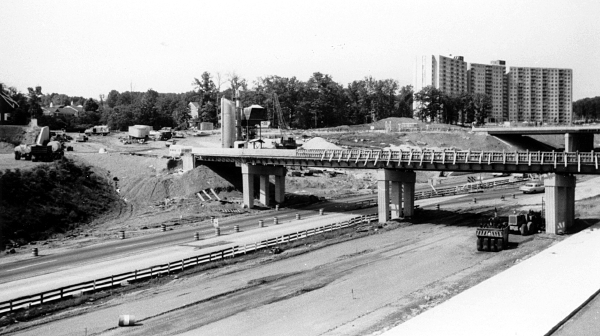This 75th Anniversary lookback article originally ran in the February 2018 edition of the All Fairlington Bulletin.
Today, Interstate 395 – or Shirley Highway – is an 8-lane freeway and the focus of discussion about extending HOT lanes and adding sound barriers. According to the Virginia Department of Transportation, there are 52 lane-miles of roadways and ramps, with four freeway junctions and numerous local ramps, and with several interchanges to the reversible express (HOV) roadway, all within a 2.5-mile section of the Shirley Highway.
When Fairlington was built, however, things were different. Imagine that I-395 essentially stopped at King Street. And imagine that there was no bridge between North and South Fairlington. This was the case for Fairlington’s first residents. Leesburg Pike (King Street) or Route 7 was a two-lane road and what became Shirley Memorial Drive – ultimately I-395 – had been a two-lane path that would soon be made into a highway.
The Shirley Memorial Highway was named in honor of Henry G. Shirley, the head of the Virginia Department of Highways (now Virginia Department of Transportation) who died just a few weeks after approving work on the new roadway. Construction was begun in October 1941 on what was designed as a four-lane highway, referred to as State Route 350, running from U.S. Route 1 near the Pentagon south to the Occoquan River near Woodbridge.
The section of the highway from the Pentagon to State Route 7 opened with mostly two lanes in October 1943. All four lanes were opened a year later but the full length of the highway was not completed until 1952.
All of Fairlington’s original drawings contemplated that a bridge across Shirley Highway would connect North and South Fairlington and would be built at the same time as the community and the highway were being constructed. The Defense Homes Corporation, which built Fairlington, conveyed the necessary land, but the bridge was not built. In 1944, the corporation informed Arlington County that:
“…the plans for Fairlington provide for a bridge over Shirley Memorial Drive, connecting South Abingdon in the North side with 34th Street South in the South side of the project…. The bridge will be built by Federal Works Agency with Government funds. Its installation has been deferred because of the emergency and the refusal at this time of the War Production Board to grant the necessary priorities for the release of requisite materials. The work will proceed as soon as the state of emergency will permit.” (Fairlington at 50, p. 79)
The state of emergency lasted until Shirley Highway was widened in the 1960s. At that time, the long-awaited bridge was built.

Widening of Shirley Highway and building of bridge, 1966. Courtesy Fairlington Properties, Realtors
Between 1965-75, the Shirley Highway was reconstructed to Interstate Highway System standards and designated as Interstate 95. Original plans called for I-95 to cut through Washington, D.C., connecting with the Capital Beltway (I-495) in Maryland. However, community opposition halted this plan in 1977 and funds were instead devoted to the construction of the region’s Metro subway system.
The I-95 designation was rerouted onto the eastern half of the Beltway and the remaining portion of the Shirley Highway north of Springfield was redesignated Interstate 395.
Sources: Fairlington at 50: 1943-1993, Fairlington Historical Society, Catherine B. Fellow Memorial Edition, 2012. A History of Roads in Virginia, Virginia Department of Transportation, 2006